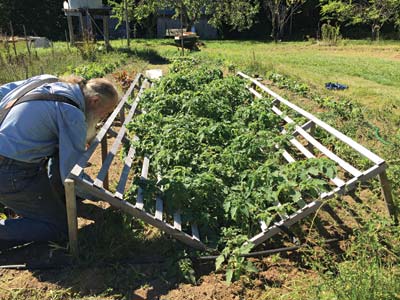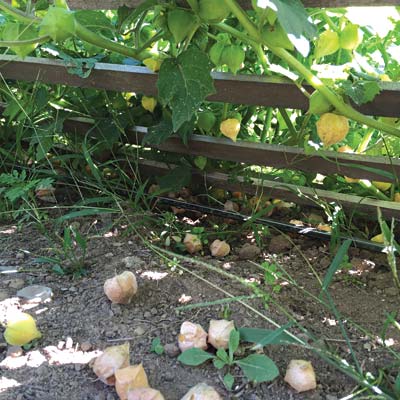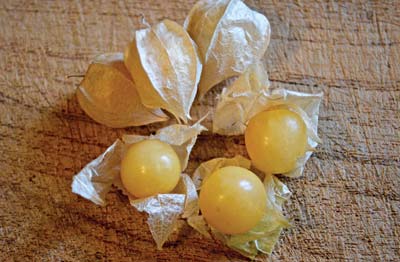 |
| The author harvests ground cherries from under a V-shaped trellis, which allows the fruits to drop to the ground while supporting the foliage. Photo by Lisa Quatrale |
 |
| Ground cherries on the ground, ripe and ready for harvest. Photo by Lisa Quatrale |
 |
| When ground cherries turn from green to yellow-orange, they are ready to be removed from their husks and enjoyed. English photo |
By Will Bonsall
Some of the Solanum plant family figure large in the food culture of many nations; try to picture a cuisine without tomatoes, peppers or eggplant (all right, Welsh; you got me there). Yet one of its most taste-tempting members – the ground cherry (Physalis peruviana) – is generally overlooked. Granted they don’t lend themselves as well to mixing with other vegetables; for me they seem to work best as a fresh, raw snack. But even for that use alone, they’re far too delightful to ignore. They are quite the sweetest member of the family, often with a strong suggestion of pineapple flavor.
Actually, the genus Physalis (which means “bladder” – I assume in reference to the papery sheath enclosing the fruit) includes a number of species that collectively are called ground cherries, the most common being P. peruviana. However the genus also includes tomatillos (P. ixocarpa), which are the basis of “salsa verde,” and the ornamental Chinese lanterns (P. alkakengi). They are nearly all of New World origin and thus, like tomatoes and peppers, were unknown to Europeans before the 16th century.
Ground cherries (no kin to true cherries) look much like small, yellow-orange cherry tomatoes wrapped in a loose, protective, papery sheath. They’re also known as “husk tomatoes” (they are distant cousins of tomatoes), Cape gooseberries (they are related to real gooseberries in common name only, and “Cape” derives from their importation into Britain from South Africa) and poha (Hawai’ian for ground cherries).
Like most of the Solanums, ground cherries have zilch tolerance for frost; in fact a good chill sends them into stress mode. Tropical crops, such as basil and Malabar spinach, seem to be so adapted to hot humidity that they totally lose it toward the other end of the weather spectrum. But while ground cherries welcome heat, they do not bear up well under drought, especially in their earlier growth, and unlike tomatoes they are not quick to snap back from a temporary wilt. They aren’t picky about fertility; however, a humus-rich soil, even if low in nitrogen, is a natural buffer against drought.
No matter how well you care for them and no matter how heavily they yield, the first frost always finds them loaded with unripe fruit, often much more than you’ve picked before then. While I should view the glass as half-full and forget about that part of the crop that wasn’t, I nevertheless have to wonder what one might do to reduce all that waste.
For one thing you can and should start them plenty early – at least as early as tomatoes – and baby them after setting out to minimize transplant shock. Starting in individual cells (at least 2- x 2-inch) is much preferred to letting them inter-root in seedling flats. That gives you an earlier crop – wonderful – but also an even bigger late crop to go to waste. End-of-season row covers aren’t enough; just protecting them from frost will not increase the overall daytime heat they need to fully ripen. A greenhouse would be the answer, I assume.
Incidentally, they’re not quite like tomatoes, which you can pick at first frost and after-ripen on a sunny windowsill. You can do that with ground cherries to some extent, but the flavor will be disappointing, even more than after-ripened tomatoes.
Although several varieties of ground cherry exist, the main ones on the market are Cossack Pineapple, Aunt Molly’s and an Austrian variety, Huberschmidt, which is sold in the United States as Goldie. All are good, but my favorite is Cossack Pineapple – not surprising, since I’m the one who selected it from several dozen accessions in the National Germplasm collection and introduced it to U.S. gardeners. It came to the National Germplasm collection from Poland, and I was impressed by its sweet pineapple-y taste tones, plus nice yellow color, often blushed with orange. I guess others agree, since I’ve spotted it in seed catalogs from as far away as Tasmania. I’m certain it came from me, because although the variety didn’t originate with me, the name did. I sometimes wonder if Aunt Molly’s isn’t the same thing; it’s also excellent.
A typical way to grow ground cherries is to let them live up to their name and sprawl on the ground. A major problem with this is that the ripe fruits tend to drop off and lie unseen under the foliage. Some people tie the plants up to a vertical trellis, which I find requires too much maintenance while they’re growing. I have contrived an alternate system that works very well for me. As shown in the accompanying photo, I lean two trellis sections away from the plants at less than 45 degrees to the ground. The growing plants sprawl on these with little attention to training, while the dropped fruits are easily collected from the ground beneath.
Fortunately, ripe ground cherries can be stored for several weeks after harvest due to their papery cases, which keep them dry and lightly separated. If left too long they may rot, but they’re far more likely to wither into “raisins,” which, in fact, is one way folks use them. Puree, whether canned or frozen, is another way to process and store ground cherries. The seeds are much smaller than tomato seeds – and thus pass through the strainer – yet are harder. An elderly lady friend of mine who grew up on an Iowa farmstead described using then in pies and jam. Euell Gibbons wrote about dipping the fruits into chocolate (or carob?), sort of like “petit fours.” All fine with me; I just like to grab a handful in passing, pop them out of the husk and into my mouth.
About the author: Will Bonsall lives in Industry, Maine, where he directs Scatterseed Project, a seed-saving enterprise. He is the author of “Will Bonsall’s Essential Guide to Radical Self-Reliant Gardening” (Chelsea Green, 2015). You can contact Will at [email protected].